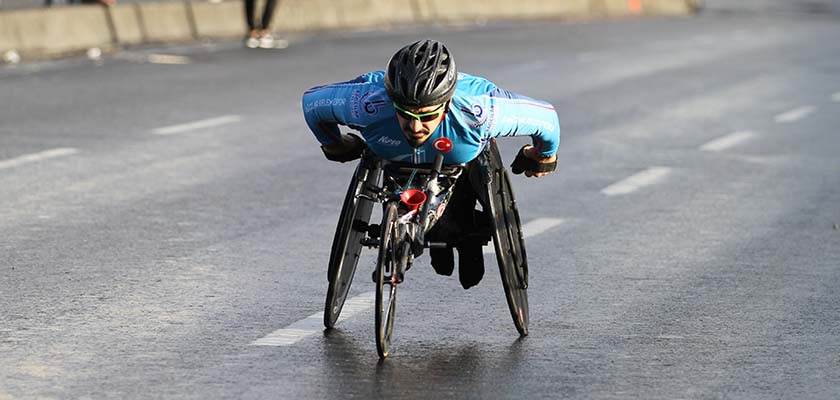Do you already know everything about Paralympic athletics? Great, now it’s time to get a better understanding of the disciplines and classification processes. Check out our complete guide to the rules of Paralympic athletics.
The rules of Paralympic athletics are laid down by the International Paralympic Committee (IPC) and the national athletics federations of each country.
We can see that these regulations vary according to the athletes’ disability category and the type of event they are competing in.
Participate in our free WhatsApp community and receive daily tips, news and trivia from over 50 sports! Click here to join.
What is the difference between athletics and paralympic athletics?
Paralympic athletics is an adaptation of conventional athletics for athletes with physical, visual or intellectual disabilities. In the adapted version, athletes are grouped into different categories according to the type and degree of their disability.
In addition, Paralympic athletics often requires specific adaptations and equipment to accommodate the needs of athletes with disabilities.
The rules of Paralympic athletics may also undergo minor changes for each disability category, under the premise of maintaining fair competition for all athletes.
These rules can vary from conventional athletics to accommodate the different needs of competitors.

Paralympic athletics rules: classifications
In the rules of Paralympic athletics, the rankings are based on the type of disability the athlete has. It was done this way to make the competition as fair as possible for the participants.
So the classification of the paralympic athlete comes with a letter and a number: the letters can be T (“track”) for track events and F (“field”) for field events. Meanwhile, the numbers represent the handicaps, as you can see below:
Visual impairment
- T11: Athletes with total absence of vision or very limited vision.
- T12: Partially sighted athletes with the ability to perceive shapes at close range or with peripheral vision.
Physical Disability
- T31 to T34: Athletes with cerebral palsy who compete in running and javelin throwing events.
- T35 to T38: Athletes with cerebral palsy or other disabilities who compete in running, jumping and throwing events.
- T51 to T54: Physically disabled athletes competing in wheelchair racing events.
- F40 to F46: Athletes with amputations or other disabilities who compete in running, jumping and throwing events.
Intellectual Disability
- T20: Athletes with intellectual disabilities who compete in running, jumping and throwing events.
Paralympic athletics rules: modalities
The paralympic athletics disciplines share many similarities with conventional athletics, but can also include some differences and adaptations to meet the needs of PCD athletes. Check out the list:
Track Racing
- 100m
- 200m
- 400m
- 800m
- 1500m
- 5000m
- 10.000m
Barrier races
- 100m hurdles
- 400m hurdles
Wheelchair Racing
- 100m
- 200m
- 400m
- 800m
- 1500m
- 5000m
- Marathon
Obstacle Course Racing
- 1500m with hurdles
Relay
- 4x100m
- 4x400m
Jump
- Long Jump
- High Jump
- Triple Jump
Throws
- Weight throw
- Javelin throw
- Disc Throw
- Club throwing
Launches
- Disc Throw
- Javelin throw
- Club launch
Combined Tests
- Decathlon for Visually Impaired Athletes
Road Trials
- Marathon
- Street races (5km, 10km, Half Marathon, etc.)
Paralympic athletics rules: adaptations
Paralympic athletics starts follow the same basic rules as conventional athletics: athletes must wait for the signal and remain in the starting position until the race begins.
In relay events, athletes must exchange batons within a designated zone. Adaptations can be made for athletes with visual or physical disabilities, ensuring a smooth transition between runners.
Adaptations can be made to ensure safety for all competitors, such as:
Guides for visually impaired athletes
In races involving visually impaired athletes, the use of guides is permitted. Guides are trained runners who accompany visually impaired athletes and provide verbal guidance during the race.
Wheelchairs
In wheelchair racing events, athletes use wheelchairs adapted specifically for sports competitions. The wheelchairs must meet the safety regulations and technical specifications laid down by the sports federations.
Paralympic athletics rules: fouls and penalties
In Paralympic athletics, as in conventional athletics, there are fouls and penalties to ensure the integrity of the competition and compliance with the rules.

For example: if an athlete starts running before the start signal, this is considered a false start. The athlete may receive a warning for the first false start and be disqualified if they commit a second false start.
If an athlete invades another competitor’s lane during a race, it can also result in penalties, depending on the severity of the infraction. If the track invasion is deemed intentional, the athlete may be disqualified.
In relay events, baton changes must be made within the designated transfer zone. If a team makes an exchange outside the zone or commits another infraction during the exchange, this may result in the team being disqualified.
Roughly speaking, any action that unfairly interferes with another competitor can result in penalties. Each event in Paralympic athletics has its own specific rules.
You already know the rules of paralympic athletics, but there are many other sports to follow and learn about. Be sure to check out our content:



